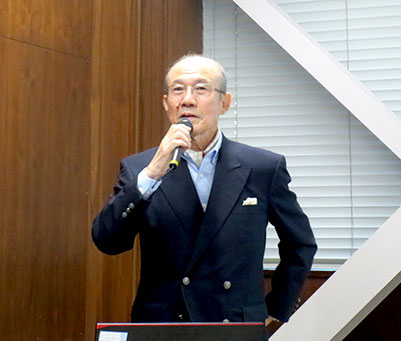
Former Administrative Vice-Minister of MAFF Mentioned “We need futures market for rice ”(the first half volume)
Dec. 20, 2023
Mr. Yoshiaki Watanabe, the President of Niigata Agro-Food University
At the seventh Agricultural Market Study Group held by Agricultural Policy Research Committee Inc., Mr. Yoshiaki Watanabe (photo), the President of Niigata Agro-Food University, appealed for necessity of rice futures. After He served as the administrative vice-minister of Ministry of Agriculture, Forestry and Fisheries (MAFF), he became the president of Tokyo Grain Exchange, and when the rice futures transaction was listed on the exchange in August 2011, he emphasized the potential and importance of futures trading, saying “It can play a very valuable role in terms of providing a fair price indicator and establishing a place for hedging”. In this lecture also, he started with the origin of rice futures and concluded “We need futures market for rice” correcting misconceptions about futures trading that persist in Japan. In this article, we will post the discussion notes“Rice futures-common sense and insane sense” summarized by him on which he based his lecture and we would like to share usefulness of futures trading on this article.
“Commodity Futures”began for the first time in the world when the old Dojima Rice Exchange received official approval from Edo Shogunate in 1730. It was 118 years before Chicago Board of Trade (CBOT) that opened in 1848. Today, futures trading is thriving all over the world, however, in Japan, its birthplace, although it is said to be“Economic Infrastructure”, especially futures trading in agricultural products is in a dire state.
Rice is produced one time per year consumed all year round, and there are good and bad harvests. There are transportation from production area to consumption area and storage issues. So, it can’t escape from the risk of “A crash in the fall and a sharp rise in the off-season period” as it is. In addition, in Edo era (1603-1868), as rice served as a currency and a standard of value, if the price of rice goes down, it affects the life of the samurai class, and if the price goes up, problems arise in the lives of ordinary people. Therefore, stabilizing the supply and demand of rice was the greatest concern of the ruler, General, Tokugawa Yoshimune in those days.
In Edo era, although gold, silver and currency existed, “Silk and cloth in eastern Japan” and “Rice in western Japan” served as a standard of value, a medium of exchange, and a salary like currency. (“Agricultural policy and folklore” written by Yoshihiko Amino)
About rice whose price was declining due to development of new fields, improved productivity and good harvest, interfering with the samurai’s life, General, Yoshimune encouraged an increase in bids and stored rice through “Rice futures trading” that was previously conducted unofficially and in the dark, and officially granted permission to the system that could provide prices up to the next harvest.
Mr. Watanabe, the speaker, mentioned the following.
In any case, futures trading only promotes “large losses due to speculation”, and furthermore, there are obvious misunderstandings “Futures trading causes price fluctuations ” ,“It amplifies and accelerates price declines ”and so on. However, “They aren’t ” from past experiences and facts as well as an academic perspective. I would like to explain about several main items regarding“Futures trading is the system that serves to level out, stabilize prices, adjust supply and demand, and fulfills the insurance function for business continuity. ”
① During the Taisho era rice riots in 1918, as spot rice prices soared, so did rice futures prices. The Minister of Agriculture and Commerce at the time, Nakakoji, ordered“The cause of the price hike is futures, so stop the futures trading ”. A futures trader at the time, Kanichi Masuda, argued “The causes of the soaring prices are the supply-demand relationship and extremely sluggish monetary policy. Even if you attack the market traders, the price won’t go down, and forceful rice price control measures will lead to shortages and sharp price increases during off-season periods ”.
The results were as the futures trader, Masuda, said. Prices reflect supply and demand conditions and financial conditions.
② When we see rice supply and demand, and its price fluctuation before World War II,
⑴ as for price variation coefficient from 1901 to 1939, spot rice : 11.2, rice in futures trading : 8.9
⑵ rice price in futures trading has small price range fluctuations, so “It moves to correct up and down fluctuations” in spot rice price, that is the leveling function works(by Hironori Yagi, professor of the University of Tokyo).
① Because many speculators will participate in futures trading and take on the risk, “hedge ”will be thereby fulfilled. Speculator is also called risk taker.
② The purpose of producers, etc. who hold physical goods is hedging, so they don’t need to speculate at all.
Because rice is a staple food, isn’t“Stability of supply and demand, and prices in a medium- and long-term perspective ” necessary?
① Showing fair and open prices stabilize production and management, leading to stability in people’s lives.
②If supply and demand can be accurately adjusted through “Price discovery function” in futures trading, it prevents price declines due to overproduction, leading to effective use of local resources such as land, capital and labor force. Although agricultural groups once opposed futures trading without proving anything saying “Approving the trial listing of rice futures trading will obviously hinder the adjustment of rice production”, it is out of the common sense in developed countries such as“futures is economic infrastructure”.
(to be continued)
(Futures Tribune・issued December 8, 2023 ・no.3257)
Link(Japanese site)
©2022 Keizai Express Corp.